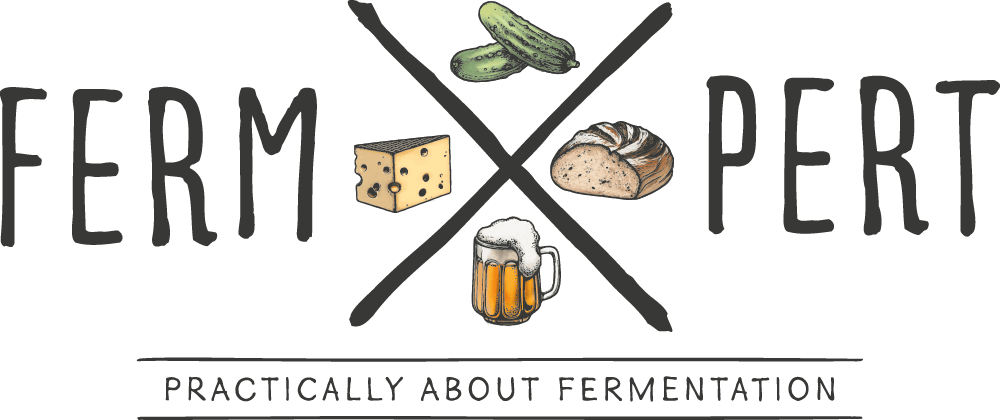It’s common knowledge that sugary carbonated drinks are, to put it mildly, not the healthiest. Is it possible to make such a drink at home so that it contains less sugar and at the same time is flavourful and refreshing? Of course it is. Today I’m taking a look at homemade lemonade.
Recipe
Homemade lemonade can be prepared in a multitude of ways, using various ingredients. The recipe given below makes a base lemonade. The ingredient ratios are adjusted to my personal taste and naturally can be modified. The amount of sugar can be tweaked, as well as the amount of lemon juice. I discuss this in more detail in the section Additional Information. The amounts given below yield 1 litre of lemonade. Of course, a typical batch is bigger than that – in my case, it’s usually 5 litres.
Ingredients
- water
- 2 lemons’ worth of freshly squeezed juice
- 50 g sugar
- 0,1 g yeast
Method
Pour the lemon juice into a vessel. Top with water to get 1 litre. Thoroughly dissolve sugar in the liquid. Dissolve the yeast in a bit of the liquid, then mix with the rest. Pour into bottles and close them tightly. Flip top bottles are ideal. Store at room temperature for 2-3 days, then transfer to the fridge to slow down the fermentation and avoid overcarbonation.
Additional Information
The above recipe is a base that can be modified to one’s heart content.
The amount of sugar can be adjusted. I choose to use 50 grams per litre, which results in a notably tart drink, but the target flavour is a matter of preference. The sugar can be substituted with a sweetener. As long as the amount of lemon juice is no less than 1.5-2 lemons’ worth per litre, there should be enough naturally occurring sugars for the yeast to carbonate the drink. It’s worth noting that lemons may vary in size and sugar content.
The amount of lemon juice is also subject to modifications. Two lemons per litre result in a tart lemony flavour that isn’t sour enough to require copious amounts of sugar. The lemon juice can be replaced with that of another fruit but in such a case, my recommendation is to experiment with small amounts of the drink. Not every type of juice will yield a good flavour. For instance, in my experience, orange juice often produces a sulphury, slightly unpleasant aroma. This is the effect of yeast activity.
The lemonade can be carbonated via other means, of course, not just by fermenting it with yeast. For immediate consumption, sparkling water is a good choice. There are also devices made specifically for carbonating drinks.
I like to boil the water for my lemonade with additional ingredients, creating an infusion that enriches the lemonade’s flavour. For this, it’s possible to use many ingredients such as ginger, tea leaves, herbs, e.g. mint, spices. It’s also possible to replace the water with freshly squeezed cucumber juice. Cucumber lemonade made this way is incredibly refreshing.
Video Transcription
I like soda. I’m also aware of how unhealthy it can be, so I rarely drink it. But when I do, I often end up making my own. Today I’m making a rather basic lemonade. The full recipe along with examples of some alternative ingredients can be found on the blog.
Before I start, I make sure I have boiling water at hand. The remaining ingredients are lemons, sugar, ginger (which is optional) and yeast.
I pour some hot water into a pot. I don’t need much, only up to about a third of the total volume. Sugar goes in too. I want to make a light infusion using ginger first. To do that, I cut a small piece and peel and slice it. The pot will stay on the hob for a few minutes. During that time, the sugar will completely dissolve and the hot water will extract some flavour from the ginger.
Lemons are next. I half and juice them.
The ginger infusion is ready so I can scoop the ginger slices out. I top it with cold tap water. The temperature of the liquid needs to be below 45°C (113°F) for yeast to successfully carbonate my lemonade. Then, I add the juice. I strain it to remove the lemon flesh. The flesh pieces are a point of nucleation, making the lemonade fizz out of the bottle when opened.
I dissolve the yeast in some liquid and then add it to the pot. All I need to do now is to fill the bottles. I leave a bit of head space in each. The closed bottles will remain at room temperature for two to three days. I check them regularly for carbonation and as soon as I see the lemonade is fizzy enough, I transfer the bottles to the fridge.
The lemonade contains two sources of fermentable sugars. The added table sugar is sucrose, a disaccharide that yeast can hydrolyse into glucose and fructose using an enzyme called invertase. The acidic environment from carboxylic acids, citric and malic among others, speeds this process up. The lemon juice contains more sucrose, as well as monosaccharides: glucose, fructose, galactose and mannose. The yeast derives energy from them through glycolysis. In the process, ethanol and carbon dioxide are produced. It’s the latter that makes the lemonade fizzy.
It’s time to have a taste. The aroma is, as expected, pleasant. Lemony, with a barely noticeable hint of ginger. The taste is exactly how I like it: slightly sour, with just enough sweetness to offset the acidity. Again, ginger is barely perceivable. It’s very refreshing and while not exactly calorie-free, due to the added sugar, it’s certainly nowhere near as sugary as store-bought soda.

